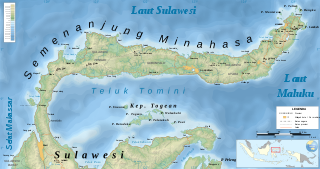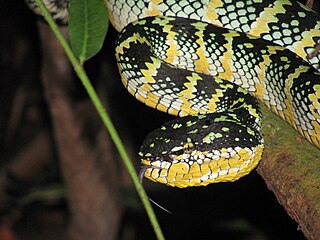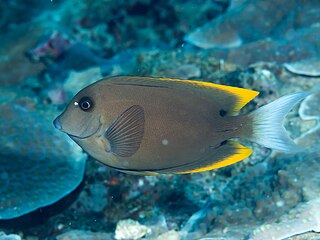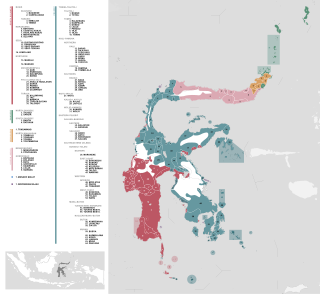Related Research Articles

Lindu people is a collection of four indigenous communities known as Anca, Tomado, Langko and Puroo in areas around Lindu Lake in Central Sulawesi, Indonesia. They belonged to the Kaili-Tomini people cluster of Sulawesi.

The Minahasa Peninsula, also spelled Minahassa, is one of the four principal peninsulas on the Indonesian island of Sulawesi. It stretches north from the central part of the island, before turning to the east and forming the northern boundary of the Gulf of Tomini and the southern boundary of the Celebes Sea.

The Gulf of Tomini, also known as the Bay of Tomini, is the equatorial gulf which separates the Minahassa (Northern) and East Peninsulas of the island of Sulawesi (Celebes) in Indonesia. The Togian Islands lie near its center. To the east, the Gulf opens onto the Molucca Sea.

Tropidolaemus is a genus of venomous pit vipers found in southern India and Southeast Asia. Currently, 5 species are recognised and no subspecies.

Ctenochaetus tominiensis, known commonly as the Tomini surgeonfish among other vernacular names, is a species of marine fish in the family Acanthuridae.
The Tomini–Tolitoli languages are a disputed subgroup in the Austronesian language family spoken off the Gulf of Tomini and the district of Tolitoli in northern Central Sulawesi province, Indonesia, consisting of two branches, viz. "Tomini" and "Tolitoli". The unity of this group has not yet been demonstrated, and it may well be that the two branches actually are not closer to each other than to other languages of Sulawesi.
The Celebic languages are a subgroup of the Austronesian languages spoken on the Indonesian island of Sulawesi, formerly called Celebes. Almost all of the languages spoken in the provinces of Central Sulawesi and Southeast Sulawesi belong to the Celebic group. A few Celebic languages are located in South Sulawesi province. By number of languages, Celebic is the largest subgroup of Austronesian languages on Sulawesi.

On the Indonesian island of Sulawesi, 114 native languages are spoken, all of which belong to the Malayo-Polynesian subgroup of the Austronesian language family. With a total number of 17,200,000 inhabitants, Sulawesi displays a high linguistic diversity when compared with the most densely populated Indonesian island Java, which hosts 4–8 languages spoken by 145,100,000 inhabitants.

The Gulf of Boni, also known as the Gulf of Bone, Bay of Boni, and Bone Bay, is the gulf which divides the South and Southeast Peninsulas of the island of Sulawesi (Celebes) in Indonesia. It opens on the south into the Banda Sea.
Kaili is an Austronesian dialect cluster of the Celebic branch, and is one of the principal languages of Central Sulawesi. The heartland of the Kaili area is the broad Palu River valley which stretches southward from Central Sulawesi's capital city, Palu. Kaili is also spoken in the mountains which rise on both sides of this valley, and along the coasts of the Makassar Strait and the Gulf of Tomini.
Bajaw is the language of the Bajaw, widely known as the 'sea gypsies' of Maritime Southeast Asia. Differences exist between the language's varieties in western Sabah, Mapun in southern Philippines, eastern Sabah, and across Sulawesi to Maluku.
Boano is a Sulawesi language of the Austronesian family.
Balaesang is a Celebic language of Sulawesi in Indonesia.
Dampelas (Dampal) is a Celebic language of Sulawesi in Indonesia. It is the main language of Dampelas District (kecamatan).
Tajio (Ajio), or Kasimbar, is a Celebic language of Sulawesi in Indonesia.
Taje (Aje), or Petapa (Tapa), is a Celebic language of Sulawesi in Indonesia. Taje is a minority language with a small population of speakers, and is spoken in the Tanampedagi and Petapa villages in Central Sulawesi.
Dondo is a Celebic language of Sulawesi in Indonesia. It is not clear how distinct it is from Tomini. It is spoken along the western coast of the "neck" of Sulawesi.
The Proto-Philippine language is a reconstructed ancestral proto-language of the Philippine languages, a proposed subgroup of the Austronesian languages which includes all languages within the Philippines as well as those within the northern portions of Sulawesi in Indonesia. Proto-Philippine is not directly attested to in any written work, but linguistic reconstruction by the comparative method has found regular similarities among languages that cannot be explained by coincidence or word-borrowing.
The Gulf of Tolo, also known as the Bay of Tolo, is the body of water lying between the eastern and south-eastern peninsulas of the island of Sulawesi (Celebes) in Indonesia.

Gorontalo is a province of Indonesia on the island of Sulawesi. Located on the Minahasa Peninsula, Gorontalo was formerly part of the province of North Sulawesi until its inauguration as a separate province on 5 December 2000. In Indonesian history, the only Indonesian President from the Gorontaloan people is the third President of the Republic of Indonesia, Prof. DR. Ing. Bacharuddin Jusuf Habibie. His father, Alwi Abdul Jalil Habibie, comes from the "Habibie" clan.
References
- ↑ Tomini at Ethnologue (18th ed., 2015) (subscription required)
- ↑ Himmelmann, Nikolaus P. Sourcebook on Tomini-Tolitoli languages: General information and word lists. Pacific Linguistics. Vol. 511. Canberra: The Australian National University. doi:10.15144/PL-511.